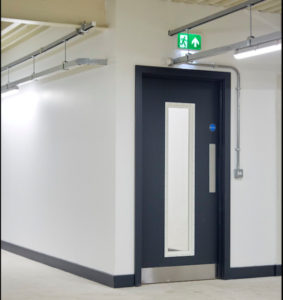The Fire (Scotland) act 2005 for Scotland and the Regulatory Reform (Fire Safety) Order 2005 for England & Wales place responsibilities on building owners and operators to ensure their fire doors are fit for purpose.
The regulations recommend checking your fire doors at least every six months, depending on the amount of usage. For example, doors that get a lot of traffic, will need more frequent inspections and maintenance – just like a car that does a higher mileage.
The 5 Step Check is simple, and can be done by anyone! We recommend everyone learns it and does it often if they are responsible for a building!
- Check for certification Is there a label or plug on the top or side of the door to show it is a certificated fire door? The ‘selfie’ function on your smartphone can be put to good use here to check… or you can do it the old-fashioned way with a mirror. If you do see a label or plug that’s good news, otherwise report it to whoever is in charge of your building.
- Check the gaps Check the gaps around the top and sides of the door are consistently less than 4mm when closed. A £1 coin is about 3mm thick, so if you have one handy you can use this to check the gaps. The gap under the door can be slightly larger (up to 8mm is not uncommon), but it does depend on the door – as a rule of thumb, if you can see light under the door, the gap is likely to be too big. It’s good news if the door fits the frame and it’s not damaged. If not, report it. If the gaps are too big smoke and fire could travel through the cracks.
- Check the seals Are there any intumescent seals around the door or frame, and are they intact with no sign of damage? These seals are usually vital to the fire door’s performance, expanding if in contact with heat to ensure fire (and in some cases smoke) can’t move through the cracks. If not, report it – the door may not be properly maintained and in the intensity of a fire may not protect you long enough.
- Check the hinges Are the hinges firmly fixed (three or more of them), with no missing or broken screws? If you see problems, report it – the door is obviously not properly maintained and in the intensity of a fire may not perform and hold back the fire for long enough. These are one of the hardest working components of any door and could be opened tens of thousands of times each year. This puts enormous pressure on the mechanism of the hinge and on its fixings.
- Check the door closes properly Open the door about halfway, let go and allow it to close by itself. Does it close firmly onto the latch without sticking on the floor or the frame? If not, report it. A fire door only works when it’s closed. A fire door is completely useless if it’s wedged open or can’t close fully.
We always recommend using a Third Party Accredited fire door inspector. This gives you peace of mind that your fire door specialist has the required knowledge and skills to undertake the work.
Failure to carry out these checks can result, as many places are now discovering, in large reparation costs as they seek to restore historically neglected fire doors to proper working function.
Here at TCS Response Ltd., we are registered with two UKAS accredited schemes – the Fire Door Inspection Scheme (FDIS) and BM Trada Q Mark. We undergo regular reassessment and bi-annual audits of our training and business processes as well as the work we have done on site, which includes fire door inspection, maintenance and installation.
By using our expertise and experience, you know you are doing everything you can to safeguard your building and its occupants.







